How to transplant currants correctly in summer, autumn and spring
It is relatively common for gardeners to transplant plants from one place to another. So you have a need to transplant your favorite berry to a new place or to plant old currant bushes.
Next, you will learn about when and how to transplant currants correctly, including the nuances of carrying out the procedure at different times (in spring, summer and autumn), so that the shrub quickly takes root in a new place and soon begins to bear fruit abundantly again.
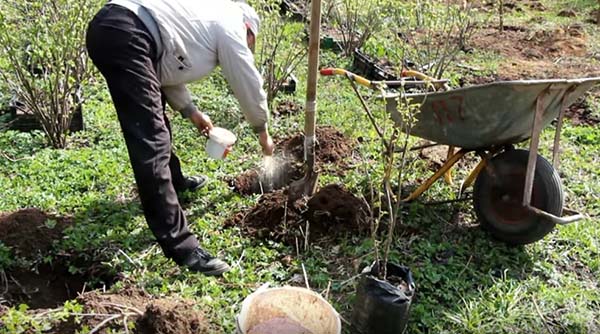
Content
Why do you need to transplant currants
The reasons for transplanting currants are different. As a rule, the shrub is transplanted in the following cases:
- The soil was depleted, and there was not enough food for the bush.
- The bush has stopped developing, the growth of young shoots is minimal.
- Fruiting decreased markedly, the berries became very small.
- The plant has grown too much, it began to take up too much space.
- You planted a fruit tree nearby (for example, cherry plum), it quickly grew, and the shrub was in deep shade, because of which it stopped bearing fruit.
- You have started a redevelopment of the site.
- You want to propagate a shrub.
Whatever the reason or purpose, renewal and rejuvenation will obviously only benefit the shrub, because the currant bush in one place should grow no more than 10-15 years.
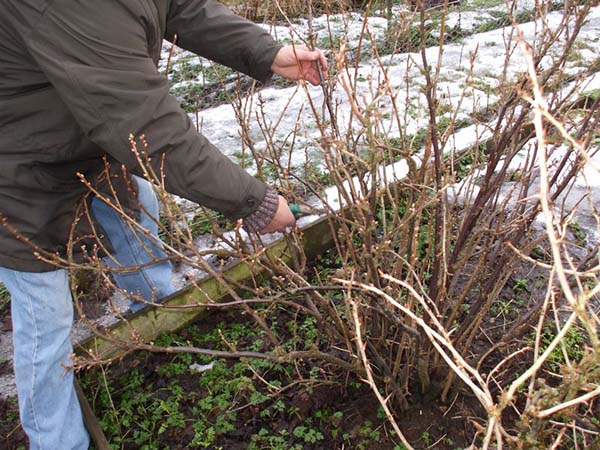
However, only bushes, which are about 3-5 years old, can tolerate a transplant well. For older plants, this is a tremendous stress, respectively, they take a very long time and do not take root well, get very sick, rarely bear fruit. Nevertheless, according to many gardeners, currants are difficult to "ruin", so in the end it will start to grow.
Features of transplanting black, red and white currants
There are no differences between transplanting and breeding methods of black, red and white shrub species.
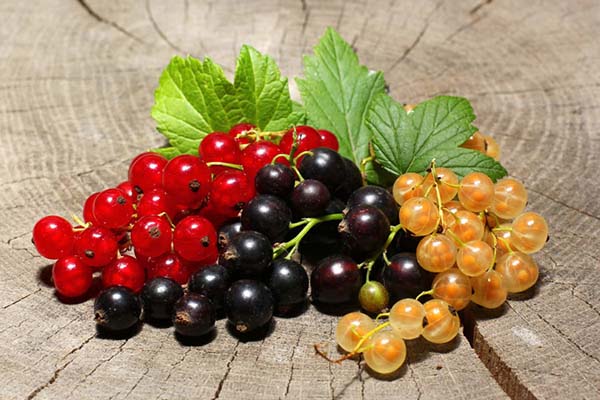
When is it better to transplant currants: in autumn or spring, is it possible in summer
As a rule, shrubs, including currants, are transplanted in the fall, but this procedure can be carried out in spring and even in summer (but with a number of restrictions). There is no particular difference between transplanting in autumn or spring, and when it is better to do this, each gardener decides independently.
The specific timing of the transplant directly depends on the climatic features of the region and the current weather conditions this year.
Transplant in autumn
The optimal time for an autumn transplant will come when the plant's growing season ends and it sheds its leaves. This means that the currants have already formed buds for the winter and fell asleep. At the same time, 20-30 days should remain until stable autumn frosts, this time is just enough for the rooting of the bushes.
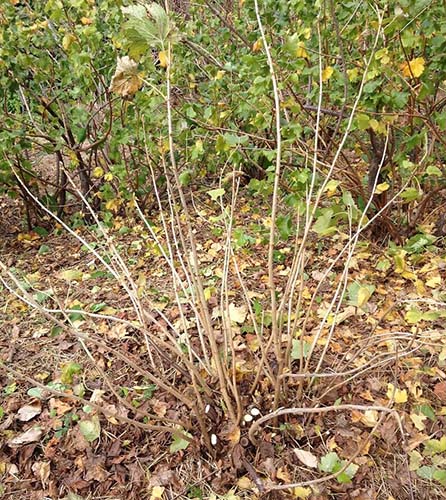
Thus, the approximate timing of transplanting currants in the fall in southern Russia is October-November, in the middle lane (Moscow region) - the second half of September-first half of October, in the Urals and Siberia - September (although it is better to transplant in the northern regions in the spring).
Transplant in spring
It is optimal to transplant currants in the spring after all the snow has melted and the earth thaws. At this time, the bush is asleep, its buds have not yet swollen, which means that if everything is done correctly, the transplant will be successful.
There is not much time, therefore, if you did not have time in the recommended time frame and the currants have already begun to bloom, then such bushes should not be transplanted. The plant may shed all flowers and become sore. It is better to postpone the procedure in the fall or do it in the summer (if really necessary).
The approximate timing of spring currant transplantation in different regions: in the south - March, in the Central lane (Moscow region) - April, in the Urals and Siberia - May.
Transplant in summer
Of course, summer is the worst time for transplanting not only currants, but also almost all plants (except strawberry and seedlings with a closed root system). Therefore, as a rule, this procedure becomes a necessary measure. For example, if you urgently need a place where bushes grow, or you sold your summer cottage altogether and want to take the bush with you to a new place.
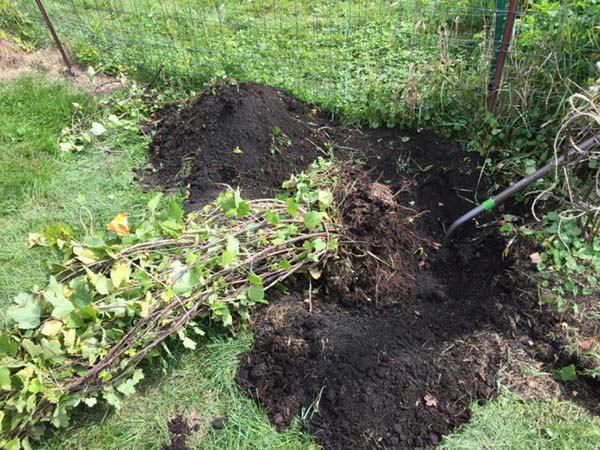
The main thing is, after transplanting currants to a new place, do not forget to carry out regular abundant watering, especially if it is hot and the air is dry. And first, be sure to carefully prune the shrub!
Video: transplanting currants in summer
How to transplant currants to a new place: rules for preparing a site
In order for the transplant to go for the benefit of the plant, it is necessary to take a responsible attitude to the choice of a place and suitable soil.
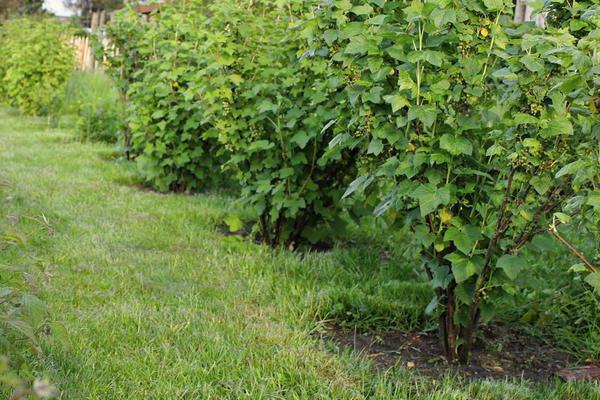
Planting site and soil
The requirements for the place for growing currants are as follows:
- It should be sunny, but not completely open (very light partial shade). It can be planted in the shade, but it will bear fruit worse and more often be affected by diseases.
- Smooth, not low-lying place, where underground waters occur more than 1.5-2 meters.
- The place should be well protected from northerly winds and drafts.
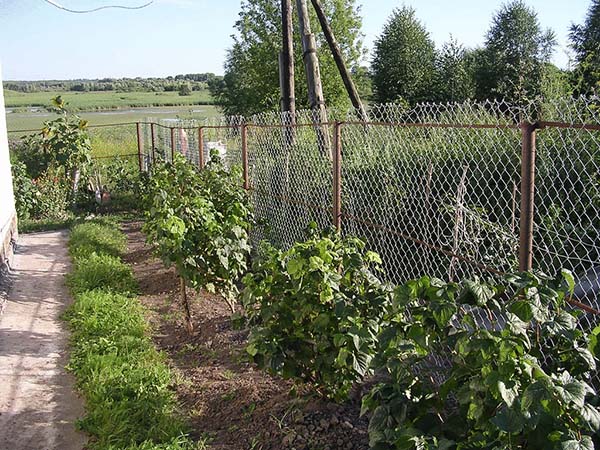
- It is better to plant at a sufficient distance from other crops (2-3 meters), as the roots of the shrubs can grow very strongly.
- The shrub loves to grow on sandy loam or loamy soil (in the first it is better to add more organic matter, in the second - additional mineral fertilizers).
Planting pit and nutrient soil
The optimal size of the planting pit for currants: depth - 30-40 centimeters, diameter depending on the size of the bush, usually within 40-50 cm.
Currants love loose, fertile soil. A nutritious substrate for filling the planting pit can be prepared as follows: mix humus, compost, potassium sulfate (20-30 grams per 1 square meter), add superphosphate (30-40 grams per 1 sq.m.), or use wood ash (100-200 grams per square meter).
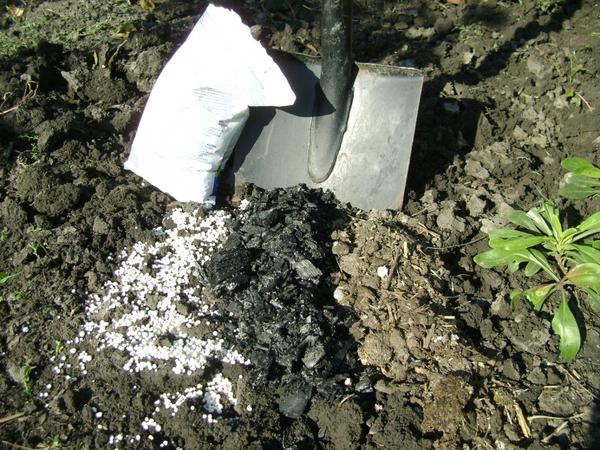
Methods for transplanting (breeding) currants
In total, there are 3 ways to propagate a currant bush:
- dividing the bush (in spring and autumn);
- layering (in spring and autumn);
- cuttings - green (in late spring-early summer) and lignified (in early spring).
Next, we will talk about the fastest way of transplanting (reproducing) currants - dividing the bush, as well as reproduction by layering.
Transplanting a young and old bush with and without division
Recommendation! Some gardeners advise to pour a couple of buckets of earth directly onto the bush a year before transplanting, and in the spring or autumn to dig it up and divide it. The bush should produce many annual shoots from the root, of course, if you water it enough.
Step-by-step instructions for transplanting currants to a new location:
- Dig up the seedling, digging from all sides, with an indent from the seedling by 30-40 centimeters.
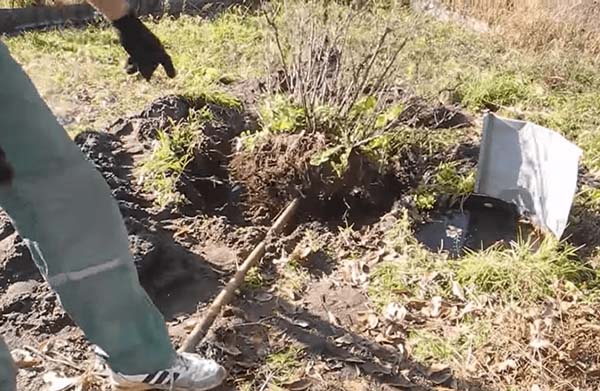
- If transportation is planned, then you can tie the branches and wrap the roots in a bag.
- Prepare a planting hole in a new place (depth - 30-40 cm, width or diameter - depending on the size of the bush itself), which should be filled with fertile soil and fertilizers, you can use humus or compost, and superphosphate and potassium sulfate (or wood ash).
- Fill the pit halfway with the nutrient mixture.
- Pour out a bucket of water.
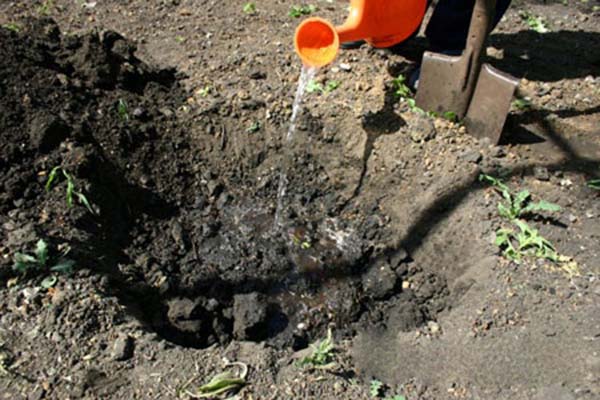
- Put the whole bush (if young up to 3 years old) or divide it into several independent ones (if the old one, then you can not divide it, you need to decide at will and need).
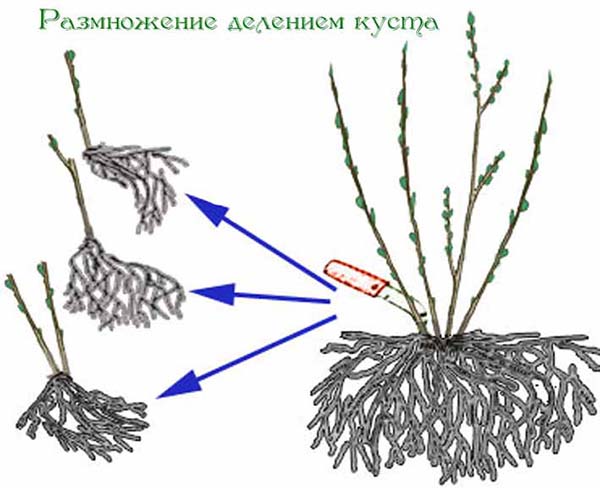
- Place the seedling in damp ground and spread out its root system. In this case, the root collar must be buried 10 centimeters below the surface of the earth.
- Cover with earth and tamp.
- Water abundantly (10-12 liters of water).
- Make a hole (near the trunk circle) and mulch.
- Perform a thorough pruning of the bush, shortening its aerial part by 80-90%, so that 2-4 buds remain on each branch.
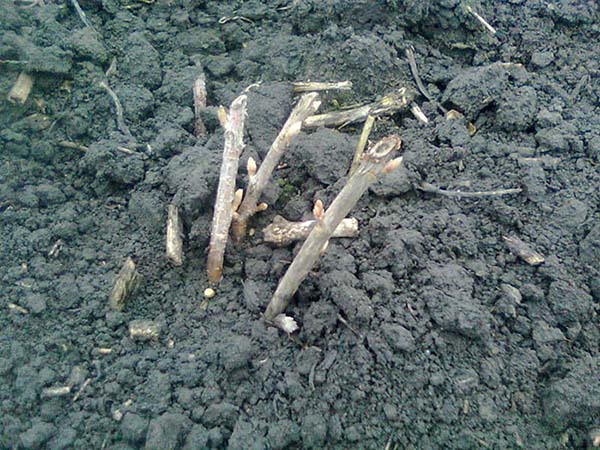
Important! Transplanting a young currant bush is performed in the same way, including with the obligatory pruning.
Video: transplanting a currant bush to a new place
Note! Many gardeners recommend not replanting or planting, but throwing out a 10-15 year old bush, before propagating it by layering or cuttings. But if you are satisfied with its fruiting, and the reason for the transplant is simply the need to change the place, then your business. In addition, propagation by layering is the fastest and best way to transplant (propagate) an old bush.
Transplant using layering
Step-by-step instructions for transplanting currants by propagating it by layering:
- Choose a suitable branch near the bush, which is directed away from the bush. It can be either a one year old or a two year old shoot.
- Dig in a young shoot (2-3 cm in the ground), additionally pinning it to the ground (for example, with a wooden slingshot). But the top of the shoot must necessarily look out of the ground.
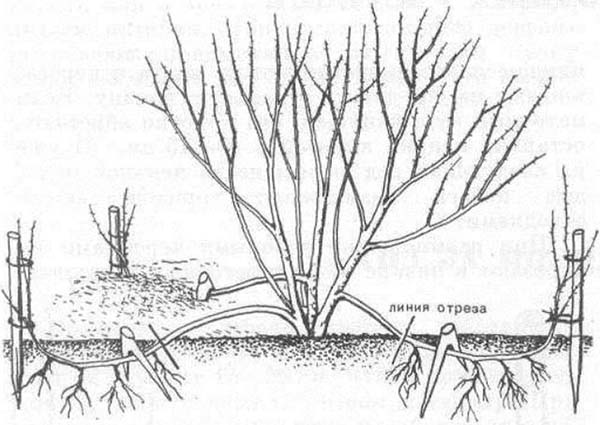
- The only requirement for care is that the soil should be, if possible, constantly slightly moist.
- After 1 year (i.e. next spring or fall) you will need to cut off the seedling from the main bush (if there are several seedlings, then they will also need to be divided). And then dig it out, digging around the circumference (from all sides), making an indent from the seedling by 20-25 centimeters, so as not to damage its root system.
- Dig a planting hole (depth - 30-40 cm, width or diameter - 50 cm), which should be filled with humus or compost, add mineral fertilizer (superphosphate and potassium sulfate or simply wood ash).
- Place the seedling at a 45 degree angle. Bury the root collar of the seedling 10 centimeters from the ground.
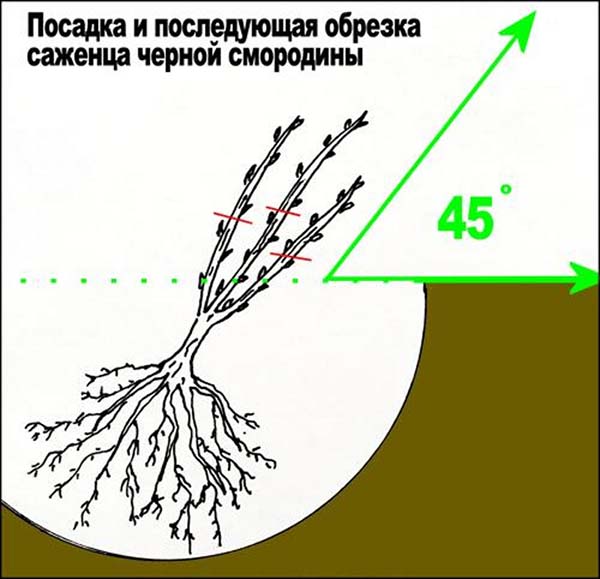
- Pour a bucket of water directly onto the seedling.
- Cover with earth that remains from the digging of the hole.
- Cut off the entire aerial part, leaving 5 hemp, maximum 10 centimeters. In this case, 2-4 kidneys should remain.
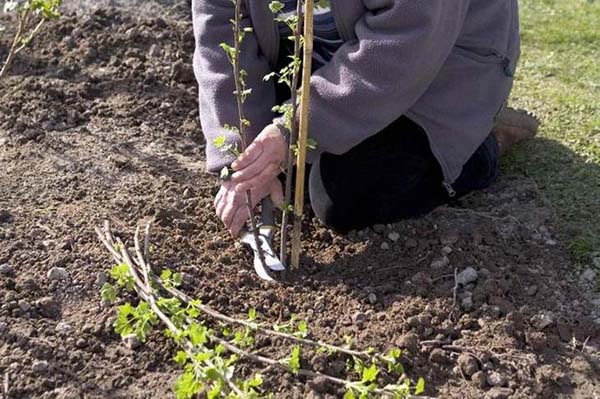
- Mulch.
Important! If you cut the branches and see that the middle of the trunk is black, then the bush infected with glass... Alternatively, you need to cut the branches even further down to keep the trunk clean.
Video: reproduction of currants by layering is the best way to transplant an old bush
You can also propagate currant bushes cuttings.
Care after transplanting currants to a new place
Further care of currant bushes will consist in regular watering (especially in the summer season). Top dressing in this and next season will not be required (for 1 year), since all the necessary fertilizers have already been applied to the planting pit.
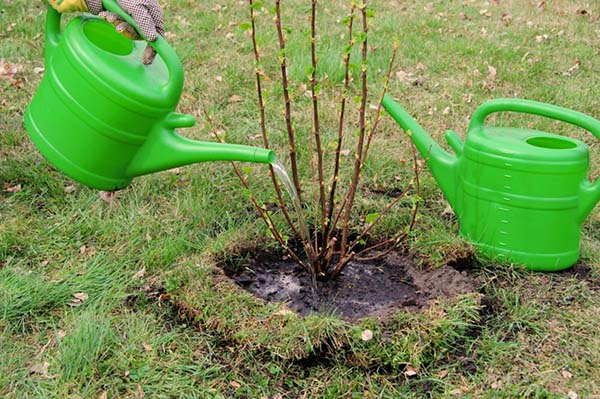
Note! You can read about caring for currants in the spring in this general article and in more detail about pruning, treatment against pests and diseases (boiling water) and feeding in the spring, and also about how to get rid of aphids on a bush.
What to do with bushes in autumn (about feeding) and how to prepare them for winter - in this material.
If you transplanted currants in spring or autumn, then you have created all the necessary conditions for its normal growth and further stable fruiting. So, high yields!
Video: how to properly transplant currants

